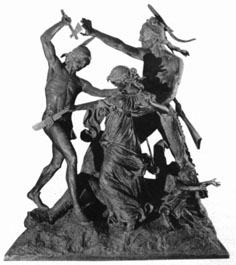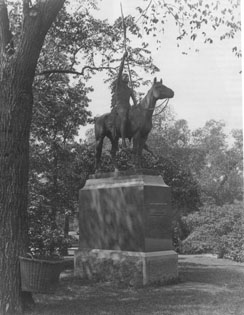<Reprinted
from Chicago
History, Spring 2004>
This
theme of the "vanishing Indian" reappeared
a decade later when Lincoln Park featured another Native American
statue. The Signal of Peace depicts a mounted Plains Indian in full
feathered headdress holding a coup stick aloft. American sculptor
Cyrus E. Dallin created the monument in Paris, and it won an award
at the World's Columbian Exposition in 1893. Although Dallin had
seen Indians in Utah during his boyhood, he based his sculpture on
Native Americans brought to Paris in 1889 by Buffalo Bill's Wild
West Show. Philanthropist Lambert Tree donated the bronze statue
to the Lincoln Park Commission.
"I fear the time is not distant," Tree explained
in a letter, "when our descendents will only know through
the chisel and brush of the artist these simple and untutored
children of nature who were little more than a century ago,
the sole human occupants and proprietors of the vast northwestern
empire of which Chicago is now the proud metropolis." Tree
blamed the government for the demise of the Native American: "Pilfered
by the advance guards of the whites, oppressed and robbed by
government agents, deprived of their land by the government
itself, with only scant recompense; shot down by soldiery in
wars fomented for the purpose of plundering and destroying
their race, and finally drowned by the ever westward spread
of population." The original placement of "The Signal
of Peace" was ironic, if not symbolic: The mounted Indian,
gesturing peace, faced the center of the bustling city yet
remained dominated
by the giant bronze figure of General Ulysses S. Grant, the
sword of the republic. The Signal of Peace now stands near
the lakefront between Belmont Avenue and Fullerton Parkway.
|
|
"The Signal of Peace",
showed a Plains Indian in full headdress. In the statue's
original
placement, it faced a monument to war hero Ullyses S.
Grant which dominated the scene. |
|
Forward to the next page of this essay
Back to the previous page
Back to Online Essays |



